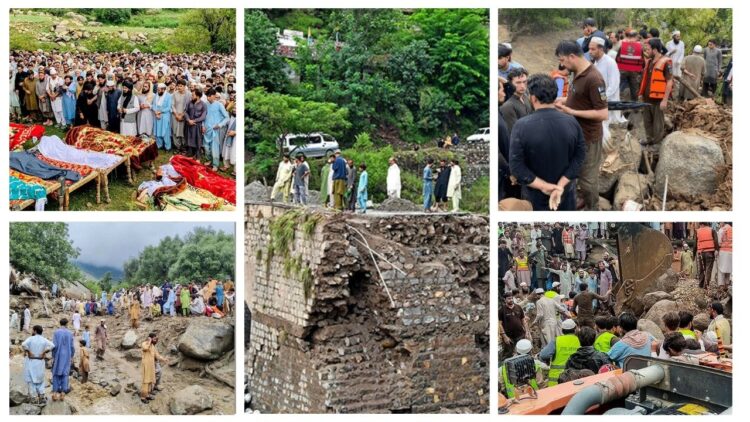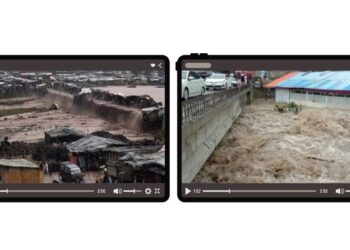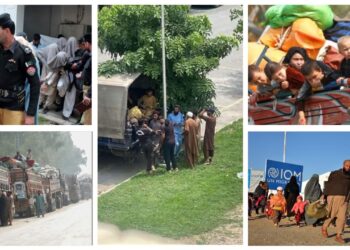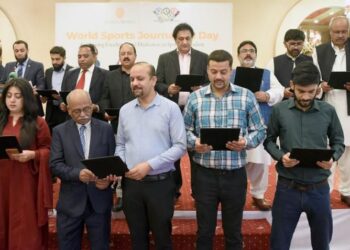PESHAWAR; At least 189 people were killed in devastating floods across Khyber Pakhtunkhwa (KP) on Friday, with dozens still missing, according to the Provincial Disaster Management Authority (PDMA).
It marked the province’s highest single-day death toll from a weather disaster in recent years, underscoring the severity of Pakistan’s ongoing monsoon season.
The monsoon rains, which began in late June, have wreaked havoc in several parts of the country, especially in northwestern KP and the northern mountainous regions, where flash floods, landslides, and mass displacement have been reported. Areas with poor drainage, dense populations, and weak infrastructure have been hardest hit.
According to PDMA, the dead included 163 men, 14 women, and 12 children. Buner district was the worst affected, with 91 fatalities reported in a single day. In total, 45 houses, three schools, and eight other buildings were completely destroyed, including 26 houses in Swat alone.
Another 37 houses sustained partial damage and seven were totally razed. PDMA has warned that heavy rains are likely to persist until August 21, posing further risks.
Acting on the directives of KP Chief Minister Ali Amin Gandapur, the provincial government released an emergency relief package worth Rs 500 million for the worst-hit districts: Rs 150 million for Buner, Rs 100 million each for Bajaur, Battagram, and Mansehra, and Rs 50 million for Swat.
PDMA has instructed district administrations and rescue agencies to accelerate operations, pre-position supplies and equipment, and remain on high alert for any emergency.
In a televised statement, Gandapur said all provincial departments and agencies are engaged in joint rescue missions, coordinated from the Chief Minister’s House control room in Peshawar. He noted that Malakand and Hazara divisions were badly affected by torrential rains and cloudbursts, which have triggered catastrophic flooding.
To aid in the relief efforts, two provincial government helicopters were deployed for rescue missions. However, one of them crashed in poor weather, killing two pilots and three crew members. The provincial government has announced a day of mourning and said the martyrs will be laid to rest with full state honors.
Buner’s Deputy Commissioner Kashif Qayyum Khan confirmed that 78 deaths have been officially recorded in the district so far, with several people still missing. The Pir Baba Bazaar and surrounding areas were completely submerged, while the Gokand mosque collapsed, and livestock losses were significant. Road access to remote villages has been cut off.
In other districts:
- Bajaur reported 21 deaths, including eight children, and eight injuries. A cloudburst in Salarzai tehsil caused extensive property damage.
- Battagram saw 15 men killed by lightning strikes, with five houses destroyed in the Nil Bond village.
- Mansehra reported 14 deaths and two injuries.
- Swat had 11 deaths, some caused by lightning and others by drowning.
- Lower Dir lost five people to a roof collapse, with three injured.
- Shangla saw two fatalities from a roof collapse.
Rescue operations have been hindered by continuous rainfall, damaged roads, and disrupted communications. In many cases, rescue teams have had to trek for hours to reach stranded communities.
Rescue 1122 has so far recovered over 157 bodies and evacuated more than 100 people to safer locations. Officials describe the situation as extremely grave but say efforts are ongoing.
Prime Minister Shehbaz Sharif expressed deep sorrow over the loss of life and directed officials to accelerate relief operations, especially in Battagram. Sindh Chief Minister Murad Ali Shah contacted CM Gandapur and KP Governor Faisal Karim Kundi to offer full assistance, including medical treatment in Karachi.
According to the National Disaster Management Authority (NDMA), since June 26, monsoon rains and floods have killed 325 people nationwide, including 142 children, and injured 743 others. Azad Kashmir, Gilgit-Baltistan, and Hazara division have also suffered significant damage.
Experts warn that climate change, deforestation, and unplanned urbanization have amplified the impact of monsoon disasters in Pakistan. Weak flood defenses and inadequate early warning systems have worsened the situation.
Gandapur has vowed that the provincial government will ensure full recovery and compensation in affected areas. Lawmakers have been directed to remain in their constituencies to monitor relief efforts and maintain close contact with victims.
The immediate priorities remain rescuing stranded people, reopening roads, and restoring communications, while contingency planning has been intensified amid forecasts of more heavy rain in the coming days.
























